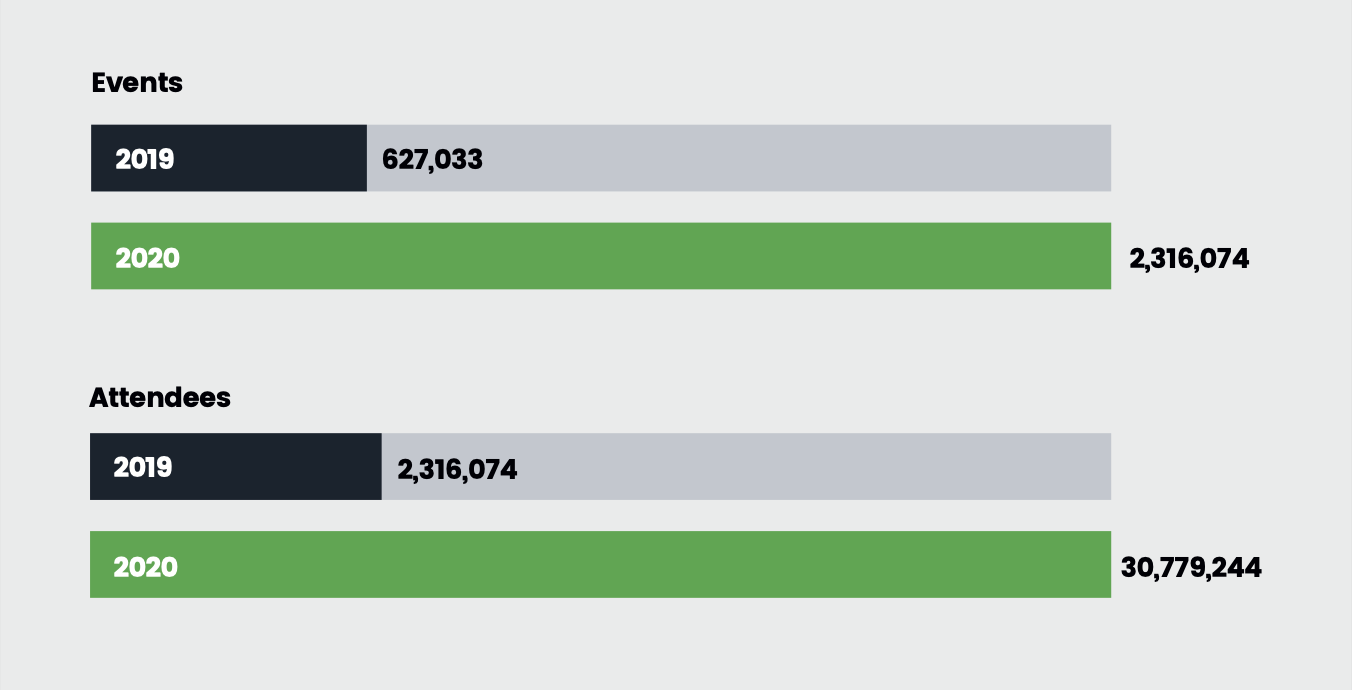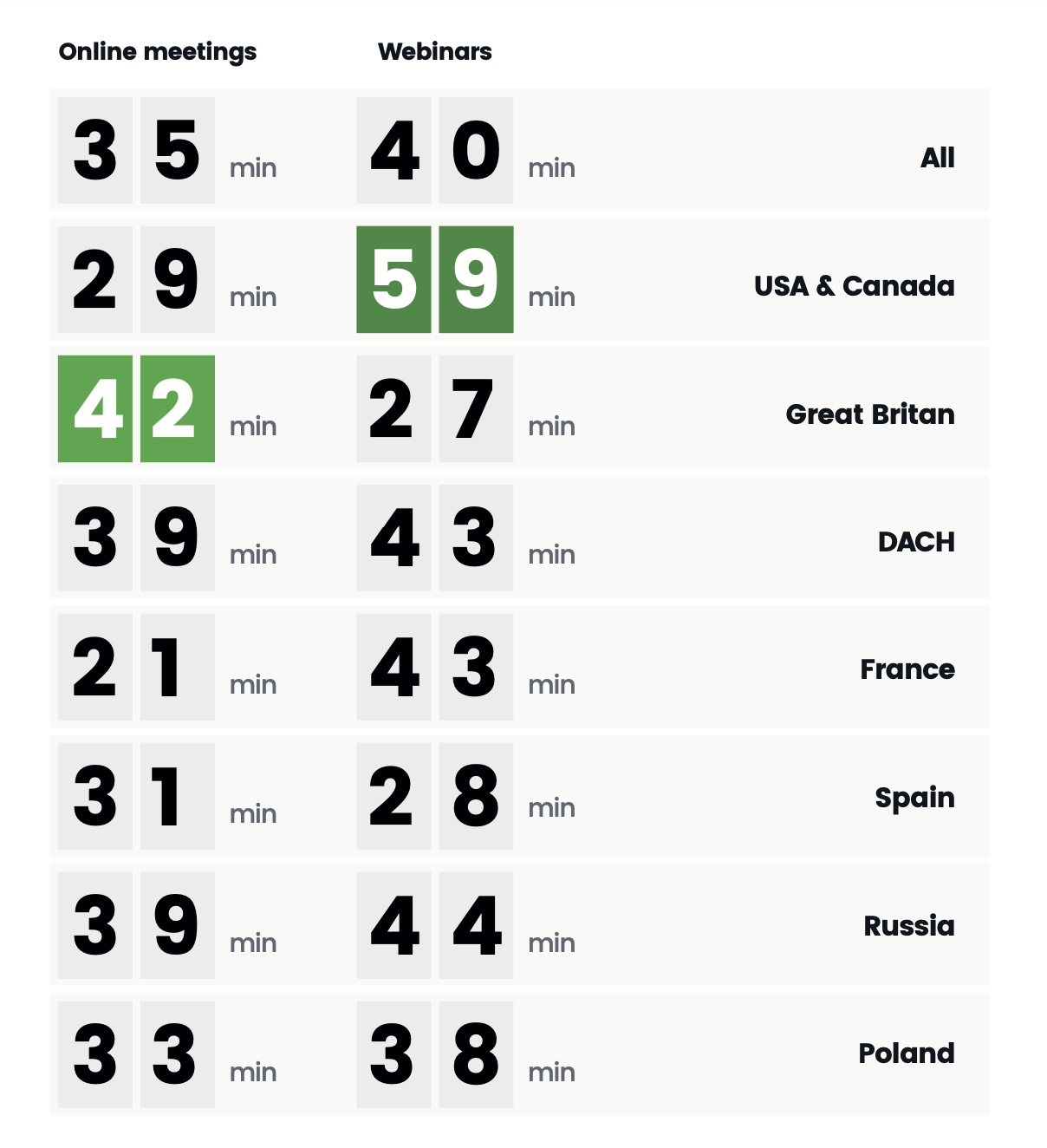2020 was a year of video conferencing and webinars. Amongst the vast array of economic and social disruptions caused by the COVID-19 outbreak, remote work and online education have become the new normal. And this is where online meetings, video conferencing, and webinars came to the rescue. How does this new landscape look like? Let’s find out from our latest State of Online Events 2021 report!
Table of Contents
The new opening for online events
Overnight, we found ourselves in a reality where educators had to teach their pupils and students in virtual classrooms. The same goes for professional courses and training sessions.
Moreover, traditional conferences have reinvented their latest editions as digital ones, and online meetups replaced regular office meetings for businesses worldwide.
These pivotal shifts explain the 270% increase in the number of events organized globally on the ClickMeeting platform in 2020, comparing to 2019.
When it comes to North America specifics, we can pinpoint that the average time spent on webinars is as much as 59 minutes, which is the highest result compared to other countries we analyzed.
DOWNLOAD FULL REPORT
Key takeaways
-
In 2020, 2,316,074 online events were held on the ClickMeeting platform, which has gathered a total audience of 30,779,244 attendees.
-
The most popular types of online events were live webinars with a result of 1,541,925, online meetings with a score of 649,367, and automated webinars – 106,478.
-
The average webinar duration was 99 minutes, whereas the average online meeting lasted for 65 minutes.
-
The average time people spent on attending a webinar is 40 minutes, while online meetings kept their attendees in the event room for an averagely of 35 minutes.
-
Tuesdays, Wednesdays, and Thursdays have been the most favorite days for organizing online events.
-
Online events’ hosts favored the Presentation tool (which stands for a PowerPoint presentation, spreadsheets, PDFs, doc files, and other content formats) – this feature was in use for 53% of online events in 2020. The second place on the podium goes to the Screen sharing, which was put to action during 18% of web conferences.
-
$ 2,034,124,62 – is the total amount of money earned worldwide through organizing paid webinars.
The world rushed to online events
The “stay-at-home” situation forced millions of people worldwide to transfer activities conducted onsite to the online reality.
From lectures and classes, through business meetings, all the way to industrial conferences – they all had to transform into virtual events.
That major shift is backed up by numbers – in 2020, there were 2,316,074 online events organized on the ClickMeeting platform, which gathered as many as 30,779,244 attendees.
To put that into perspective, back in 2019, we’ve counted 627,033 events with a broad audience of 8,504,770 attendees.

Taking online events conducted in 2020 under the microscope, we can say that the ClickMeeting was a platform where organizations from all over the world hosted:
-
649,367 online meetings – a type of online events created to get and work together in a group of up to 25 people. It’s a solution that comes in line with a need to meet with team members, board members, managers, associates, customers, trainees, or students.
-
1,666,584 webinars – the widespread usage of this form of online events comes from the fact that hosts can gather up to one thousand attendees in one virtual event room and stream their content with the use of audio-video, share their presentation and other file formats, showcase their products and offerings by sharing their screens and create a two-way communication through chat, surveys and polls, and Q&A mode.
-
842 huge virtual events AKA webcasts – looking at online meetings for 25 people as a microscale, it’s time to jump to a macroscale and highlight the webcast technology which allows broadcasting content to a staggering 10 thousand viewers! Huge virtual events were an answer for the event industry which was strongly hit by the lockdown.
Types of webinars in 2020
Throughout the years, technology has evolved and allowed us to create new types of webinars, apart from a regular, live webinar.
Live webinars
As the name suggests, live webinars happen in real-time, allowing hosts to interact with a broad audience on the go. Live webinars are an ideal match for onboarding and training purposes, sales and marketing events, and product demos.
This classic version of webinars is still the most popular – in 2020, on ClickMeeting alone, there were 1,541,925 live webinars.
On-demand webinars
With this type of webinar, organizers pre-record their webinars to release it to their contacts, leads, or students so they can watch it anytime and anywhere they want.
On-demand webinars are a way to go when it comes to generating leads or running online courses. It depends on whether an on-demand is free or gated with a paid access, but we’ll go back to that.
Here, we are looking at a number of 8,759 free on-demand webinars in 2020. It is worth noting that this option is still relatively new and in the early adoption stage.
Automated webinars
Unlike on-demand events, automated webinars (also with two variations – free or paid) occur on a specific day and hour. However, just like above, organizers need to have a recorded material first and then enrich it with a Call-To-Action, a video clip, or a survey.
This kind of event broadcasts totally on autopilot, which lets organizers reinvest their saved time. However, there’s also a hybrid model – automated webinars, which a host can hop in to moderate the chat and answer questions in real-time.
If you look again at our data, we can see that as many as 106,478 free automated webinars took place in 2020.
Paid webinars
One of these solutions is the paid webinars, which, long before the pandemic, proved their value as a direct way to organize commercial training sessions or online courses.
In a very simple way, teachers, trainers, or private schools could earn money on their educational offer, regardless of the geographical location of their customers – students or trainees. The new reality has reinforced this type of webinars as a tool for monetizing knowledge and skills.
Let the numbers do the talking again:
- The number of paid live webinars in 2020 – 6,201
- The number of paid automated webinars in 2020 – 1,431
- The number of paid on-demand webinars in 2020 – 948
Although live webinars take the lead again, the analysis clearly shows that many entrepreneurs employed automation (on-demand and automated webinars go on autopilot) to earn money in those challenging times.
Purposes for running online events in 2020
Now it’s time to scrutinize online events when it comes to their goals. Remote work and online education have certainly been dominating traditional and social media since March 2020, but let’s have a look at our data concerning business purposes hiding behind video conferences.
Online courses and training sessions
One of the leading aspects of the COVID-19 times is that schools and universities had to close their premises and continue their educational programs in virtual classrooms.
Overnight, e-learning had to replace traditional learning, and that necessity also referred to the training industry and private academies providing professional courses.
This reality finds confirmation in our data. As much as 44,2% of online events organized on ClickMeeting in 2020, were online courses (15,1%) and training sessions (29,1%). Please note that within a training category, we also include internal training events and onboarding training sessions.
Product demos and marketing events
The second major category is the last decade’s heritage of using webinars for sales and marketing purposes. Reaching leads and customers regardless of their location is the heartbeat of running online events in the first place, and social distancing only enhanced a previously established trend.
That said, we’ve recognized that 36,5% of online events in 2020 were related to sales and marketing. This category breaks down into product demos (22,5%) – which are an excellent solution to showcase and sell both virtual and tangible products, and marketing events (14%) – which are about sharing valuable knowledge to generate and nurture leads.
Online business meetings
In 2020 we entered an era where online communication and online collaboration are inevitable to keep companies going – from solopreneurs, through start-ups, small and medium companies, up to large enterprises.
Video conferencing apps and platforms have become primary tools for daily activities, such as daily or weekly team meetups, recruitment video calls, board meetings, or small web conferences organized to run workshops, close sales deals, or pitch angel investors.
Among all online events that went on air in 2020, we classified 19% as online business meetings.
Online events in 2020 – how often, how long, and when?
Let’s take a closer look at the time aspect of running web conferences.
What’s the average time of an online event?
In real life, we can come across online meetups that last for about 10 minutes, but there are also conferences scheduled to go live for several hours.
Here’s how the average time of online events looked like in 2020:
-
Online meetings – 65 minutes, which reflects the standard 1-hour-meetings we remember from the office days.
-
Webinars – 99 minutes – which backs up an opinion about this type of video marketing as long-form content.
Here’s how does the online event dwell-time looked liked in particular countries:

The first place of the webinar podium goes to the US and Canada. We can interpret it as proof of a greater maturity these countries have in organizing and attending webinars.
The most popular days for running online events
What’s the best day to organize a web conference? We’ve looked into our data, and we must say that every day of the week had some results, but there are three distinctive leaders (in that order, regarding the average number of events on air):
- Tuesday
- Wednesday
- Thursday
The weekend is obviously at the very end of the list, but with no null results. Mondays and Fridays have been quite busy but not as much as the above three musketeers.
The most popular hours for running online events
OK, since we know what days have come victorious from this comparison, it’s time to look at the time of the day.
Here are the top 10 hours with the most significant results:
- 3 PM
- 8 AM
- 7 AM
- 2 PM
- 9 AM
- 1 PM
- 12 PM
- 4 PM
- 11 AM
- 10 AM
So, the conclusion – the office hours and early morning is the best time to throw a virtual get-together.
The most favored features used during online events
The tremendous demand for online meeting and webinar platforms in 2020 didn’t come from anywhere. For educators to teach and train, for marketers to share insightful content, and the team members and managers to collaborate efficiently – video calls are not enough.
The variety of multimedia and interactive features that all teachers and professionals can capitalize on during video conferences is the aspect that moves the needle.
In this section, we’re giving an overview of the ClickMeeting’s features over 2020, dividing them by the below categories.
Engagement and interaction
It turns out that the Presentation feature is the most favorite tool used by hosts and presenters during 53% of events.
The second place goes to the Screen sharing feature (18%) with a universal appliance for online collaboration, education, or sales and marketing.
Next, we have the Whiteboard (6,7%), which is perfect for educators to put down notes, draw visuals to explain complex topics, and the YouTube (6,4%) feature, which allows playing a chosen video clip directly from YouTube but within the event room.
Survey (5%) and Call-To-Action (2,6%) tools still seem to be underestimated and on their way to be discovered as practical functions to gather invaluable feedback from attendees (Surveys) and drive more sales results (CTA button).
E-mail communication
Organizing webinars and virtual summits doesn’t boil down to only preparing the content for the event.
We also took the usage of email communication available in ClickMeeting under our microscope.
We distinguish three types of messages events’ organizers can send to their attendees, before and after an event:
-
Invitations – in 2020, there were as many as 18,076,014 email invitations that landed in recipients’ inboxes.
-
Invitations reminders – we are talking about a mind-blowing total of 44,435,097 emails reminding recipients about upcoming events.
-
Thank-you emails – as many as 17,423,043 emails have been sent to events’ attendees after the final whistle. Thank-you emails on ClickMeeting include a customized text, uploaded files, and a link to the event’s recording (provided the recorder was turned on).
Paid online events – money-making machine
As with every crisis, the pandemic forced people to look for alternative ways to back up (or replace) their revenue sources.
Selling knowledge and practical how-to’s through paid webinars, online courses, and training sessions emerge from our analysis as a big winner.
In our last year’s State of Webinars, we highlighted that all paid webinars hosted in 2019 on the ClickMeeting webinar platform had generated a total of $ 366,000.
That’s already impressive, but let’s now compare it with all the paid events organized in 2020. We are talking about a staggering total of $2,034,124.62 earned worldwide, which is an increase of 455%!
Final words
There is no doubt that the pandemic fueled enormous changes in how we work, teach, train, run businesses, and communicate our brands with audiences.
Accelerated digitalization of all educational, marketing, and business processes found its confirmation in hard data:
-
2,316,074 online events were held on the ClickMeeting platform, which gathered a total audience of 30,779,244 attendees.
-
$ 2,034,124.62 – the total amount of money earned worldwide through organizing paid online events.
However, with experts warning about the burnout syndrome and lower training quality, this should be a north star for organizations running online events in 2021:
- High-quality;
- Security;
- Stable technology;
- Building connections;
- Engagement and contributing;
Dominika Paciorkowska Managing Director at ClickMeeting – Videoconferencing, online meetings, and webinars have become the “new normal.”This new reality, that forced people worldwide to switch to online communication, is reflected both in our data and in reports based on external data. It will therefore come as no surprise that ClickMeeting, as a platform, will consistently strive to help people stay connected and conveniently host any online event type – small, large, huge, live, or automated. That’s why we no longer deliver technology to host just webinars, but in a broader perspective, we are a platform to host online events of all shapes and sizes. Hence, our report changed its name from the State of Webinars to the State of Online Events.









